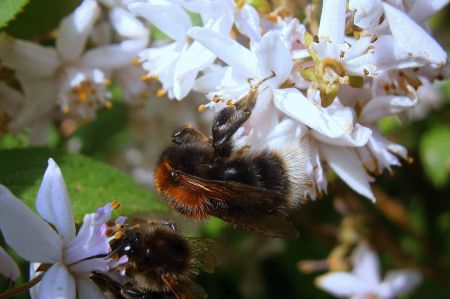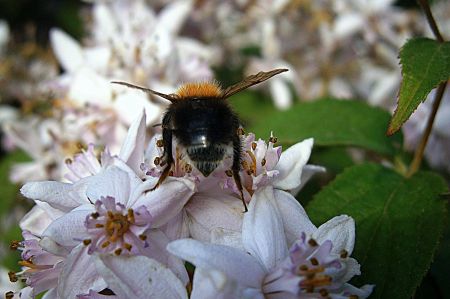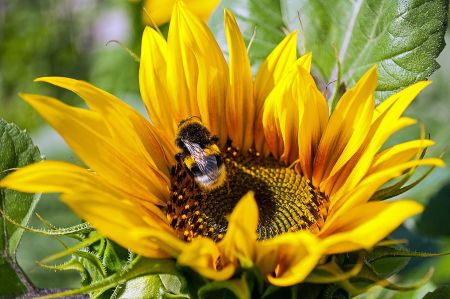Bumblebees are the first heralds of spring when pollinating
- Written by Portal Editor
Due to their size and their loud buzzing sound when flying, bumblebees are well-known representatives of insects, which today play an increasingly important role in human cultural history.
With the death of many urgently needed bee colonies due to the use of pesticides and the environmental problems of increasingly narrow habitats, the importance of bumblebees in terms of plant pollination became more and more important. The bumblebee was once even a ghost in people's minds.
Bumblebees in popular belief and as spirits of the dead

The popular belief of the money-bringing goblins, which should be locked in the form of bumblebees in the purse and would protect it from drying up, is different. A honey thief who manages to steal the honey from the bumblebees unnoticed should also find great treasure.
The increasing importance of bumblebees in pollination

Today, however, the knowledge of the importance of the bumblebee is much more advanced and attempts are made to use the bumblebee more intensively in the pollination of plants, and in particular to propagate the protection of the bumblebee. The most powerful instrument of bumblebee protection is an adequate supply of food with bumblebee-friendly wild plants, herbs, perennials, shrubs and trees over the entire bumblebee year from mid-February to the end of October.
Especially in early spring from mid-February to March and in summer from mid/end of July to the end of October, the supply is often insufficient. In residential areas, this effect is intensified by the fact that insect-friendliness has played at most a subordinate role in garden culture in recent decades and therefore many flowering plants that are largely worthless for bumblebees (and other insects and birds) have become widespread in gardens and green spaces, e.g. B. forsythia, magnolia, common lilac, cherry laurel and many cultivars with double flowers. Insect-conscious hobby gardeners, garden/landscape architects and municipal green space offices now often plan their new plants or redesigns with the help of relevant flowering calendars, which indicate not only the flowering time but also the nectar and pollen value of the various flowering plants.
If you plant the right plants, you can support them all year round
As soon as spring arrives and the sun slowly warms up the earth, the new bumblebee queens crawl out of their hibernation quarters. The furry wild bees can fly at temperatures as low as two degrees above zero. With their tiny muscles in their thorax, they generate heat by shivering and thus reach a body temperature of up to 30 degrees. Bumblebees are therefore among the first flying pollinators of the year.
Tom Bluth, wild bee protector at the German Wildlife Foundation
In the wild, the number of flowers unfortunately decreases rapidly. It is therefore very important that sufficient forage plants are provided for pollinating insects in gardens or on balconies. "If you want to help bumblebees, plant early-flowering stone or pome fruit such as plums, cherries or apples, or willow and maple varieties, service pear and dogwood and berry bushes," explains Bluth. Suitable bulb plants, which can also be planted in tubs on the balcony, are grape hyacinths, snowglow, crocuses, winter agarics and squills. Wild perennials such as hellebore, coltsfoot and shepherd's purse also provide bumblebees with vital pollen and nectar early in the year.
"Due to the increasingly hot and drier weather from May onwards, bumblebees often have a bottleneck in their food supply well into August," explains Bluth. Now red, horn and white clover help, but also viper's bugloss, knapweed, kitchen herbs or thistles, which are cultivated until autumn. "Anyone who also allows wilderness in their garden can watch bumblebee-friendly plants grow for free," recommends the wild bee protector.
Myth of stinging bumblebees
When stung, a poison is transferred to the victim. In an emergency, for example if you step on a bumblebee, it can lead to an immediate sting. The same is also possible when holding a bumblebee. Otherwise, however, they rarely sting and warn beforehand with a defensive reaction. First, they raise their middle leg toward the attacker. When threatened, they throw themselves onto their backs, stretching out their spikes in the attacker's direction, and growling loudly as they do so. If you don't retreat, you can attack. Since bumblebees, which are less agile than honey bees, may hold on to the target with their mouthparts in preparation for a sting, they may appear to bite during their attacks.
In humans, the sting pinches only slightly, but a sting can also be painful due to the injected venom, which differs from the venom of bees. The consequences are pain, redness, itching and swelling. Like the stings and venoms of bees and hornets, bumblebee stings are harmless to most people. Only for allergy sufferers is there a risk of a severe allergic reaction. A bumblebee's stinger has no barbs, so it doesn't get stuck in the victim like a honey bee's.
In collaboration with
Jenifer Calvi / Press Officer / German Wildlife Foundation
Christoph-Probst-Weg 4
20251 Hamburg
Please read as well:
